Michigan, the only state in the United States with two peninsulas, is home to some of the best tourist attractions across the nation. This can be attributed to the fact that the state has 103 different state parks, and to top it all, five national parks. For this reason, it shouldn’t come as a surprise that Michigan is also home to some of the most colorful birds in the world. Among the most common birds in Michigan are the finches. Finches are some of the smallest songbirds you can find all across the United States, and they come in different colors and sizes. In this article, we’re taking a look at the finches in Michigan and surrounding areas.
If the mention of these birds rings a bell to you is probably because Charles Darwin studied them during his personal exploration of the Galapagos Islands. Even though not most species of finches are native to Michigan, you can still easily spot them whenever you tour the state.
Michigan is home to about eight species of finches, including Red Crossbill, Pine Siskin, Purple Finch, House Finch, Common Redpoll, White-winged Crossbill, Hoary Redpoll, and American Goldfinch.
The most common species to spot in Michigan is the American Goldfinch. It’s also important to note that most of these finches are not native to the state of Michigan. However, Michigan’s geographical location along the Canadian border makes the state ideal for visits from the Northern birds.
The best thing about the Michigan finches is that you can spot them almost anywhere across the state. Whether you’re in the Upper or Lower Peninsula, you’ll likely spot some of these species.
If you’re wondering what unique features you should look for when sighting finches, do not worry. This post will explore the different species of finches, fun facts about them, and how you can attract them to your home.
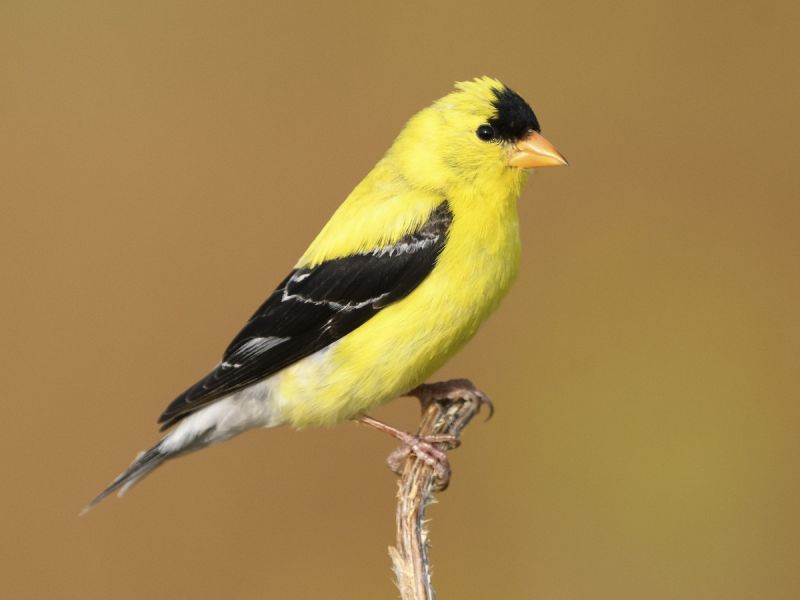
1. American Goldfinch
By far the most common finches in Michigan, you can spot the American Goldfinches all year in the state. These are also among the fascinating songbirds you can find anywhere all over the world.
They are best known for changing their feathers’ colors through different seasons. For example, during the breeding seasons, the male American Goldfinches down bright yellow feathers and have black wings.
As winter approaches, you’ll spot these birds with browner feathers. On the other hand, the females have yellow feathers, only that the color is duller than the male ones. During the breeding season, you’ll likely spot the male and female American Goldfinches flying around together in search of a suitable nesting spot.
When they finally find it, the female will proceed to build the nest. During this time, the male American Goldfinch will be flying around the nest, ensuring that the female is protected at all times.
These birds make a variety of sounds, but the most common one you’ll hear is spelled out po-ta-to-chip. Even though the American Goldfinch isn’t a native of Michigan, they’re still the most common species you’ll spot in the state.
While you’ll likely spot them around the state all year, they’re mostly located in the northern regions during their breeding seasons. If you’re looking to attract these birds to your garden, then you’re in luck.
This is because they’re likely to visit any birdfeeders you have in your backyard, and the best thing is that they’re not picky about the seeds they eat. However, if you want to impress them, nyjer and sunflower are their favorites. It’s important to note that these birds rarely eat anything but seeds.
Their measurements are;
- Length: 11-14cm
- Weight: 11-20g
- Wingspan: 19-22cm
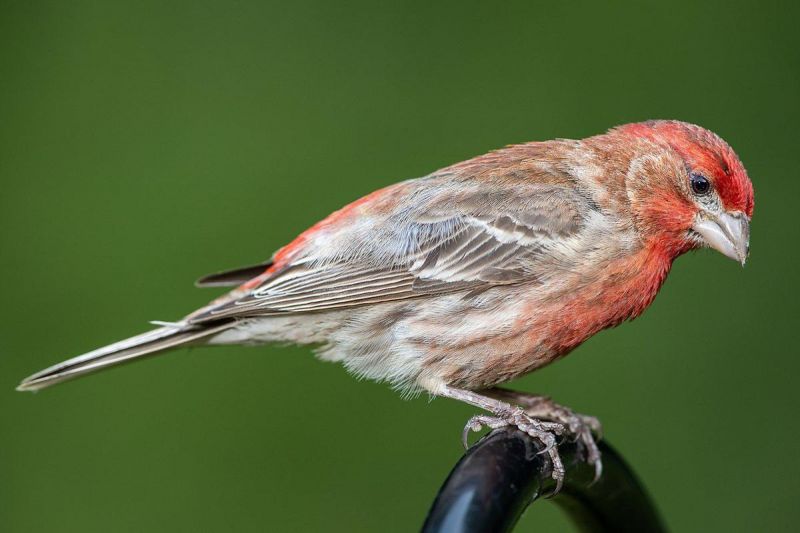
2. House Finch
House finches are also some of the most common finches in Michigan. Even though they’re mostly nest in the deserts of the southwest, these birds are highly adaptable and can inhabit almost anyplace, including cities, parks, and suburbs.
These birds have smaller bodies compared to other songbirds. The female House Finches have dull brown feathers, while the males have reddish feathers. The widespread nature of these birds all over the United States involves a very interesting back-story.
It is believed that during the 1940s, certain New York pet shop owners were selling these birds illegally to the public. After the authorities found out, fearing they would be caught and charged, the owners released the birds into the wild, and that’s why they are so common in the United States.
If you’re looking to attract these birds to your home, it will interest you to know that they prefer birdfeeders they can perch on rather than the ones with platforms. Even though these birds can be spotted all year in various parts of Michigan, they’re common in the southern regions.
The best way you’ll succeed in attracting these birds is by leaving some back oil sunflower seeds on your feeders.
Their measurements are;
- Length: 15cm
- Weight: 16-27g
- Wingspan: 20-25cm
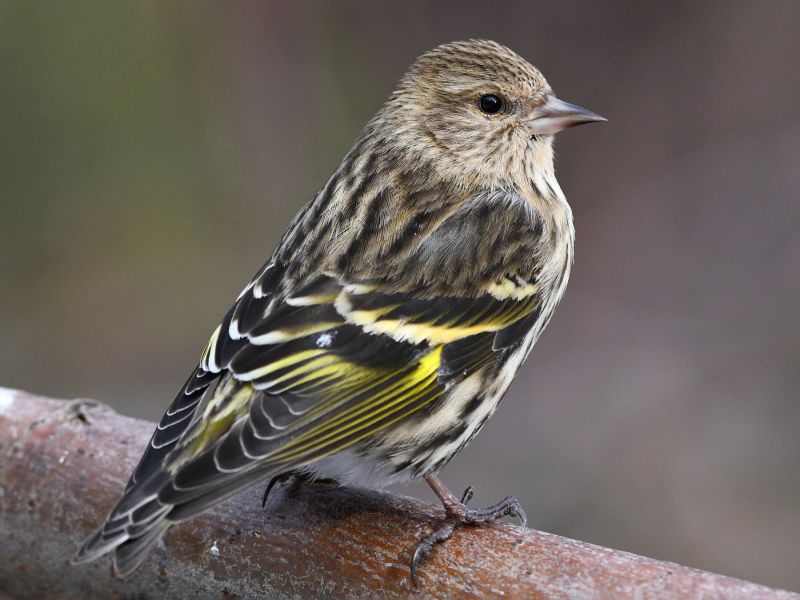
3. Pine Siskin
Pine Siskins are known to be petite finches slightly smaller than the American Goldfinch. One feature that makes the Pine Siskin so unique from other finches is that they have pointed beaks that are much slender for finches.
These birds are mostly covered in streaky brown plumage, although they down yellow markings on their tails and wings. The Pine Siskins often appear in colonies that are loosely structured than complete hierarchies.
These colonies are likely to stay together even during the mating season. In order to court a female, the male Pine Siskin performs a routine mating song while perching from higher grounds.
During the winter, when food is scarce, members of the same colony will start being aggressive towards each other. The best news for birdwatchers is that they can spot this species all around Michigan.
However, they are most common in the southern and central regions of the state. The best time you can attract these songbirds in your garden is during winter. This is because, at this time, they usually expand their search for food outside their comfort zones. Like the name suggests, this species mostly feeds on pine seeds.
Their measurements are;
- Length: 11-14cm
- Weight: 12-18g
- Wingspan: 18-22cm

4. Hoary Redpoll
These are among the rarest species you’ll find in Michigan. The Hoary Redpoll is mostly covered in grey and white feathers. However, the make Hoary Redpolls have a unique patch of red feathers on their chests and heads.
Like the Pine Siskins, the male Hoary Redpolls usually sing to the females hoping that they will be interested in mating. They will even go as far as feeding the female with the aim of solidifying the courtship.
Even though the male Hoary Redpoll is monogamous, there have been reports of the females accepting courtship advances from more than one male. Like with most of the other finches in Michigan, the female Hoary Redpolls are responsible for building the nests during breeding seasons.
These nests are famously known to resemble a large cup made of woven grass. This species is most common in the arctic tundra, where they normally build their nests. If you’re looking to spot the Hoary Redpolls in Michigan, you might have to wait until winter when they’re migrating, where you’re likely to spot them in the northern regions of the state.
It is very unlikely to spot these birds around your birdfeeders during regular seasons. However, if you’re looking to attract these birds, winter is the best time since food is scarce and they’re looking for alternatives. Nyjer seeds are the most effective way you’ll attract them to your feeders.
Their measurements are;
- Length: 11.4-14cm
- Weight: 11-20g
- Wingspan: 18-23cm
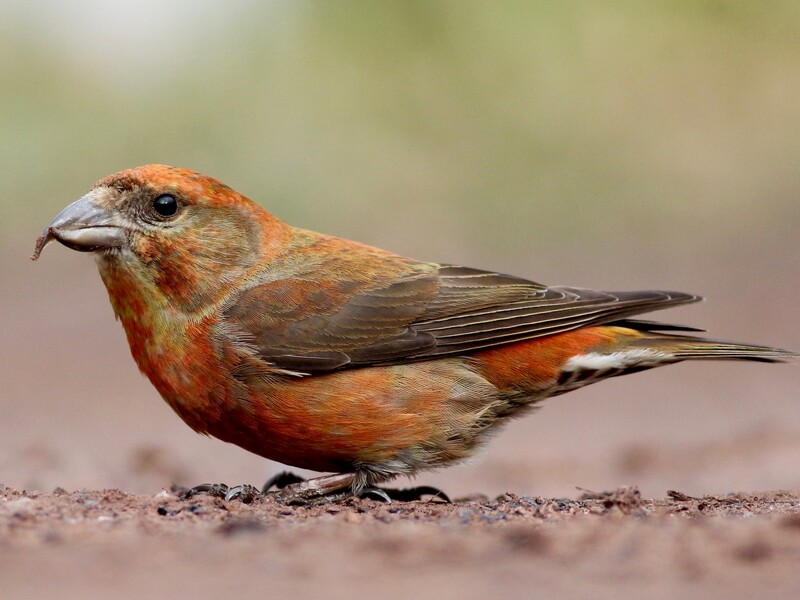
5. Red Crossbill
This species stands out from the other finches in Michigan for different reasons. They have crisscrossed beaks that are suitable for breaking into conifer cones. For this reason, it is highly unlikely to spot these birds outside the coniferous forests.
These birds are characterized by their red and grey feathers that are evident in both males and females. The Red Crossbills usually form large flocks that tend to last even through the breeding season.
Even though Red Crossbills are known to be monogamous, it’s still not known whether it’s the same mate each year. These birds are very common in different parts of Michigan. However, the time of the year determines where you’re likely to spot them in bigger populations.
If you’re looking to spot the Red Crossbills in Michigan, you might want to visit the north and central regions of the state because they’re more common there. It’s important to note that these birds only visit the southern parts of Michigan after their breeding season.
If you’re a birdkeeper and looking to attract these birds, you’ll need to be more patient. This is because they rarely visit gardens and if they do, it’s only during the winter. During this season, ensure that you stock your birdfeeders with pine seeds among other seeds, and you might end up lucky to attract several of them.
However, it’s important to note that the Red Crossbills do not feed on seeds alone. It’s not unusual to spot these birds feeding on some insects, especially during the summer. As a result of their different and undocumented sizes, there is no known average weight, length, or wingspan for these birds.
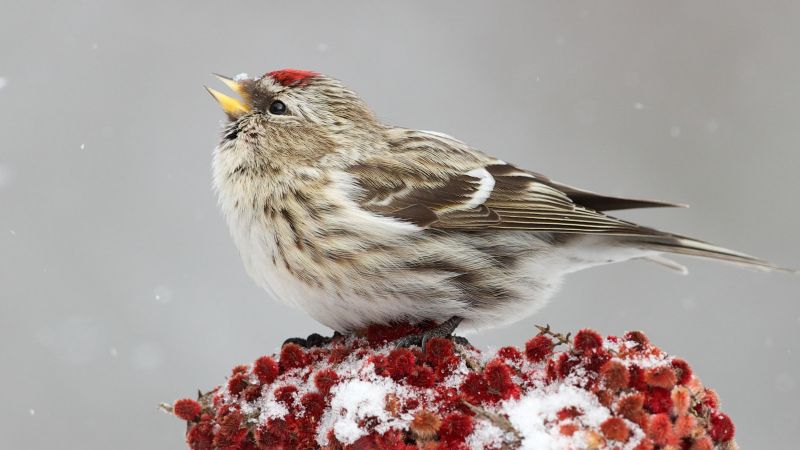
6. Common Redpoll
Unlike what the name suggests, this species isn’t so common in the United States and is mostly spotted in Michigan during the winter. The Male Common Redpolls are known for their frosty red plumage and reddish heads.
These birds have a unique pouch inside their throats, making it easier for them to store food for longer periods. On the other hand, the females resemble a washed-out red version of their male counterparts, although they still have a reddish head.
The courtship among the Common Redpolls is characterized by the male flying in circles around the female while singing a mating call. After the female gives in to their advances, the male Common Redpoll will start feeding the female to cement their courtship.
When it comes to their nesting habits, the female Common Redpoll is responsible for finding a nesting site and building the nest. Their nests are usually made from twigs and grass. Even though these birds are seen in different places all across Michigan, they are not particularly in the state all year.
They are mostly sighted in the state during winter. If you’re looking to attract the Common Redpolls into your garden, ensure that you scatter nyjer seeds on your birdfeeders, especially during the winter.
Their measurements are;
- Length: 11.5-14cm
- Weight: 11-20g
- Wingspan: 23cm
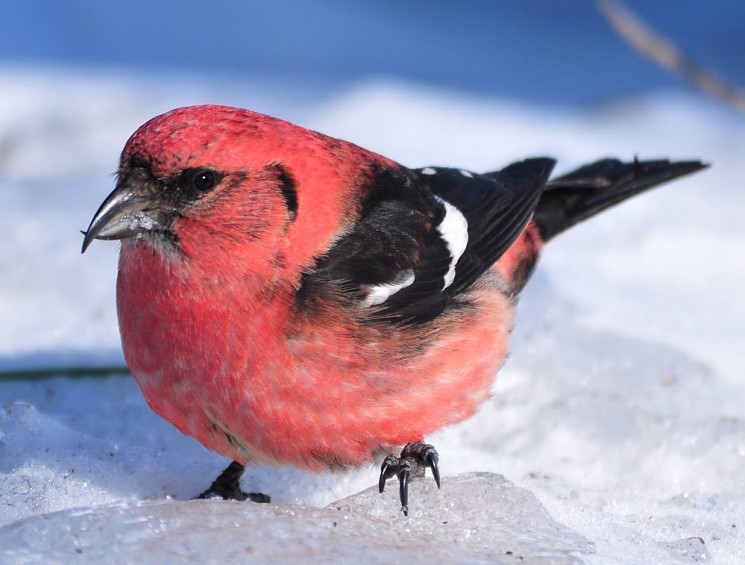
7. White-Winged Crossbill
These birds are mainly characterized by their black wings with markings on the tips. The White-winged Crossbill also downs the same twisted beak as the Red Crossbills. The males have distinct red feathers on their heads and bellies.
Like most of the finches in Michigan, the White-Winged Crossbills have a unique courtship practice. It entails the males perching on tree branches and singing mating songs to the female. It is up to the female to decide which song they like the most.
When the male is chosen by the female, it feeds her for some time. However, the White-Winged Crossbills have a particularly unusual mating routine. The males are responsible for guarding the eggs and raising the young ones.
During this time, the female White-Winged Crossbill mates with other males to increase their offspring. Even though these finches are distributed all over Michigan, they’re most common in the central and northern regions of the state.
These birds only migrate to the southern parts of the state outside their breeding season. Like the other species, you’re likely to spot the White-Winged Crossbills in your garden only during the winter.
If you’re looking to attract these birds, ensure that your birdfeeders are stocked with different varieties of seeds. This species is bigger than your average finches and weighs about 22-28g.
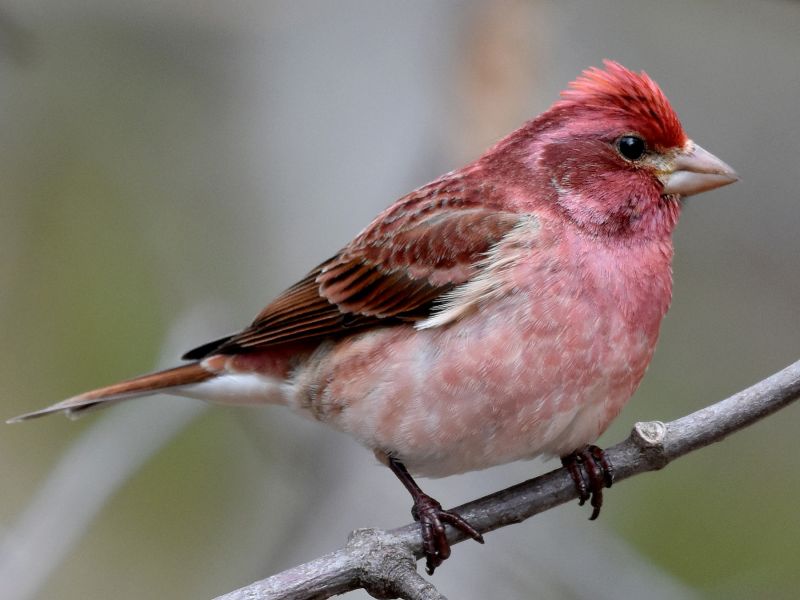
8. Purple Finch
These finches are described by most birders to look like they have been dipped in cranberry juice. However, the female Purple Finches do not share this trait. This is because their feathers mostly have brown and white streaks.
The purple finches are among the few finches in Michigan that demonstrate aggressive behavior. This behavior is most evident when there is a scarcity of food, especially during the winter. Like most of the finches, the female purple finches are responsible for building the nests as the males protect her.
Although the purple finches can be spotted all over Michigan, they are most common in the northern regions of the state. They are only spotted in the southern regions after their breeding season is over.
If you’re looking to attract these birds into your garden, ensure that you set up birdfeeders with perches rather than platforms and stock them with safflower and black oil sunflower seeds. These birds are also known to feed on flower buds and nectar.
Their measurements are;
- Length: 12-15cm
- Weight: 18-31g
- Wingspan: 22-26cm
Conclusion
Finches are some of the most beautiful birds you can sight not only in Michigan but also all over the United States. If you’re a birdwatcher looking to spot the different species of finches, Michigan is the ideal place to do so.
The best thing about sighting finches Michigan is that you won’t need to go to a specific place. Instead, you can visit your favorite destination, and you’ll still spot several of these colorful birds.
Related
- Interested in the other birds of Michigan? Check out The Birds Of Michigan!
- Ever wondered about a hawk’s hunting habits — specifically whether or not they hunt at night or if they call it a day? We investigated this very question in: Do Hawks Hunt At Night?
Thank You 😊 Very Much for the Photos !!